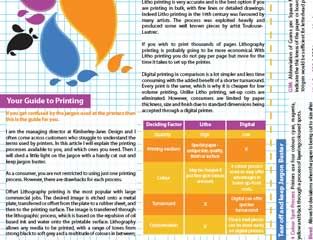I am the managing director at Birmingham based Kimberley-Jane: Design and I often come across customers who struggle to understand the terms used by printers. In this article I will explain the printing processes available to you, and which ones you need. Then I will shed a little light on the jargon with a handy cut out and keep jargon buster.
As a consumer, you are not restricted to using just one printing process. However, there are drawbacks for each process.
Offset Lithography printing is the most popular with large commercial jobs. The desired image is etched onto a metal plate, transferred or offset from the plate to a rubber sheet, and then to the printing surface. The image is transferred through the lithographic process, which is based on the repulsion of oil based ink and water onto the printable surface. Lithography allows any media to be printed, with a range of tones from strong black to soft grey and a multitude of colours in between; consumers are guaranteed a professional and high quality finish. The commercial use of Litho printing is widespread and can be found across all material from magazines to business cards.
Litho printing is very accurate and is the best option if you are printing in bulk, with fine lines or detailed drawings. Indeed Litho printing in the 19th century was favoured by many artists. The process was exploited heavily and produced some well known pieces by artist Toulouse-Lautrec.
If you wish to print thousands of pages Lithography printing is probably going to be more economical. With Litho printing you do not pay per page but more for the time it takes to set up the printer.
Digital printing in comparison is a lot simpler and less time consuming with the added benefit of a shorter turnaround. Every print is the same, which is why it is cheaper for low volume printing. Unlike Litho printing, set-up costs are eliminated. However, consumers are limited by paper thickness, size and finish due to standard dimensions being accepted through a digital printer.
| Deciding Factor | Lithography | Digital |
|---|---|---|
| Quantity | High | Low |
| Priting medium | Special paper – unique size, quality, finish or surface | x |
| Colour | May be cheaper if just two spot colours are used | 4 colour process used so may offer advantages in lower up-front costs |
| Turnaround | x | Digital can offer quicker turnaround |
| Customisation | x | Direct mail pieces can be done easily on digital printers |
Jargon Buster
4 Colour Spot Process: Printers use four colours cynthia, magenta, yellow and black through a process of layering coloured spots.
Bleed: Allows for deviations when the paper is being cut to size after printing . Generally 3mm is added to the size of all documents.
CTP: Computer to Plate. A fully digital way of producing plates where digital files are manipulated into the dot format needed to pint, and the finished plate is produced.
dpi: Dots per inch is frequently referred to in terms of image resolution or image quality.
Dummy/Proofs: A printed sample of the project which allows the user to check variants like colour.
Grind-Off: Where 3mm is ground off the spine edge of a document in preparation for binding with glue.
GSM: Abbreviation of Grams per Square Meter used to indicate the thickness of the paper or board. For example 100gsm would be sufficient for letterhead paper.
High Res PDF: A PDF image with a large amount of pixels (dpi). Standard format for printing.
Perfect Bound: A process of binding the ‘ground-off’ edges with glue to create a strong spine.
Pixels: Images are composed of tiny coloured dots known as pixels
pp: Printed pages 4pp means four printed sides in total.
Trim Marks: Cross hairs that indicate where artwork is to be cut and trimmed after printing.
Why dont you download the PDF version of this. That way you can print off the Jargon Buster.
Printing Guide and Jargon Buster < Click this button to download!

This article was originally written for Mint Business Magazine.







